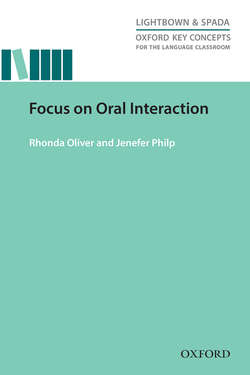Читать книгу Focus on Oral Interaction - Jenefer Philp - Страница 4
На сайте Литреса книга снята с продажи.
Introduction
ОглавлениеIn this book we will examine oral interaction theory and research as it pertains to child and adolescent second language learners. We will provide guidance to primary and high school teachers about pedagogical implications based on the findings of oral interaction research undertaken in the classroom as well as ‘laboratory’ settings. Although much has been written about oral interaction research, the focus has often been on older learners. We hope this book, with its emphasis on children and adolescents in primary and high school contexts, will serve to redress this.
The content of our book has relevance to teachers in several different settings – for example, those who teach migrant children who are learning the language of the classroom and wider community; those who are involved in Content-Based Language Teaching through a second language; and those teaching foreign language students (for example, English speaking students in an English speaking country learning Japanese, French, Spanish, etc.).
In Chapter 1, we outline what oral interaction is, and what it is not. We discuss oral interaction in more detail and as with other books in this series, we use Classroom Snapshots to illustrate the content. Key areas covered in Chapter 1 are the differences between speaking and writing, and the reciprocal nature of speaking and listening. A brief description of how oral interaction develops is also provided.
Chapter 2 explores the role of interaction for second language learning from linguistic, cognitive, social, and pedagogical perspectives. We first examine the features of interaction, including the types of communicative strategies that we all use, but especially those that child language learners engage in. We provide descriptions and examples showing how interaction provides second language input for learners, and also opportunities for learners to provide and to modify their own language output. We explore the related concepts of ‘negotiation for meaning’ and feedback within classroom activities and the research on how they facilitate language development. We also highlight the challenge that many child learners face as they are developing their oral proficiency in the target language while learning both the language and academic content simultaneously. An examination of the social perspectives of classroom interaction includes a focus on the role of scaffolding for learning, and of language development from a sociocultural perspective. In this section, we discuss the connection between social relationships and the differential benefits of teacher–student and peer interaction for learning.
Chapter 3 explores the contribution of interaction between primary school teachers and their students and between peers in the primary school classroom. We look at how this contributes to the second language acquisition process and to the learners’ academic, social, and cultural success. We explore what research suggests about the outcomes of different tasks, when used in different contexts, and also other learner and classroom factors. We also examine the role of first language use in second language classrooms. We then highlight the social importance of interaction for children – how it aids learning, enjoyment, and motivation for this age group.
